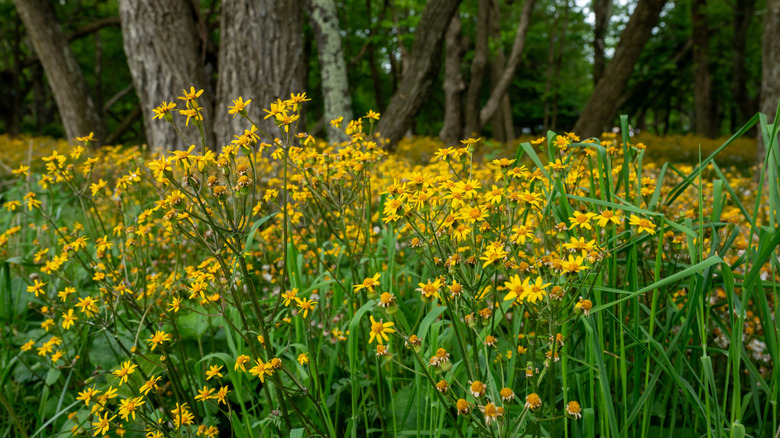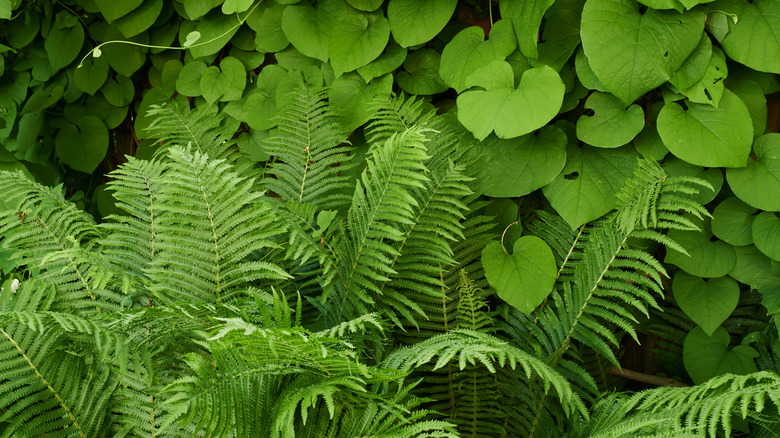The Best Companion Plants For Ground-Covering Golden Ragwort
Golden ragwort (Packera aurea) is a great shade-tolerant ground cover you can grow in winter. It's cold hardy in zones 3 through 8. It spreads out quickly by rhizomes to form a dense mat, just like turfgrass — except it tolerates shade and soggy soil better than most grasses. Its dense foliage maxes out at about 6 inches tall and is evergreen in most parts of its range. Come spring, your evergreen ground cover will burst to life with clusters of daisy-like yellow flowers on 2-foot tall stems that pollinators and gardeners alike love.
But if you're looking to add more color, a longer bloom period, or even just curate a unique bed of mixed foliage textures, finding companion plants to complement your golden ragwort ground cover can be tricky. You need something that thrives in the same wet, shady conditions. But it also needs to be able to hold its own against a companion that can be an aggressive grower, especially in sites where it gets plenty of moisture.
If you're struggling to figure out what to plant with your golden ragwort, you'll find plenty of ideas below for both flowering plants and leafy ground cover plants that love shade. All of the plants suggested like the same wet conditions and most are hardy enough to hold their ground when growing alongside a rhizome-spreading neighbor like golden ragwort. For those that aren't, a little extra help from you to help it get established should be enough to allow it to thrive on its own in your golden ragwort bed.
Flowering companion plants to extend the bloom time of your ground cover
While golden ragwort is one of the few plants that bloom even in the shade, the flowers only last for about three weeks out of the year. So if your goal is to brighten up a shady corner with a vibrant flowering ground cover, mix in other shade-tolerant species that bloom at different times of year or that have longer-lasting bloom periods. Green and gold (Chrysogonum virginianum), for example, has similar yellow flowers that appear periodically from spring through fall.
Other companions to add more yellow blooms include swamp sunflower (Helianthus angustifolius) and marsh marigold (Caltha palustris). All three spread via rhizomes or stolons which will help them compete with golden ragwort, though they may not do as well if your site is in deep shade. Another good choice for part shade is meadow beauty (Rhexia virginica). Its purple flowers appear around the same time as golden ragwort, but stay through early fall.
For deeper shade, try foam flower (Tiarella cordifolia), creeping phlox (Phlox subulata), or common violets (Viola sororia). All like shade and either have a spreading habit or self-seed aggressively enough to keep up with golden ragwort. Their flowers range from white to purple with bloom periods ranging from early spring to summer. Red baneberry (Actaea rubra) also loves shade and, after a flush of white spring blossoms, will produce clusters of showy (but toxic) berries that last into fall (or until your local birds devour them).
Leafy companion plants to create an evergreen carpet of foliage
If your main reason for choosing golden ragwort was less about the blooms and more about the chance to have an evergreen ground cover for stunning color all year round, you can level up your landscape by mixing in other shade-tolerant species that provide contrasting textures, shades, and forms to create a lush backdrop of green in your garden. Some of the easiest choices for this purpose are ferns, which typically thrive in the same shady, wet conditions as golden ragwort.
Wood fern (Dryopteris marginalis), Christmas fern (Polystichum acrostichoides), sword fern (Polystichum munitum), and autumn fern (Dryopteris erythrosora) are all great examples of ferns that will add interesting, evergreen foliage to your ground cover. Being evergreen, the shade and moisture loving ferns will have no trouble staking out some territory for themselves alongside golden ragwort. You can also add contrasting foliage by mixing in shade-tolerant evergreen sedges like spreading sedge (Carex laxiculmis), low woodland sedge (Carex socialis), rosy sedge (Carex rosea), or Pennsylvania sedge (Carex pensylvanica).
Other shade-loving species that are known for their attractive foliage include wild ginger (Asarum canadense), alumroot (Heuchera Americana), May apple (Podophyllum peltatum), and prairie sage (Artemisia ludoviciana). Of those, only alumroot and prairie sage are potentially evergreen. But all are perennials that will return every year to add interesting texture and shades of green to your golden ragwort bed.


